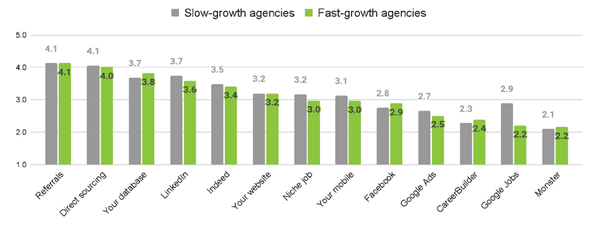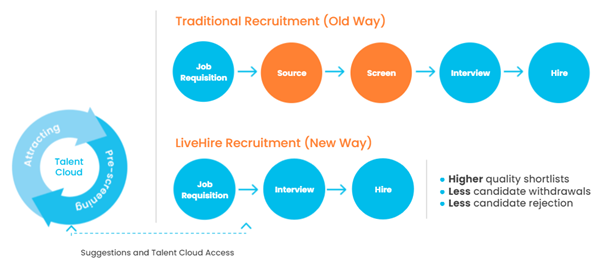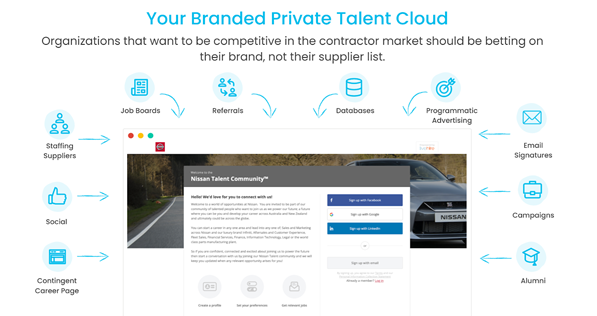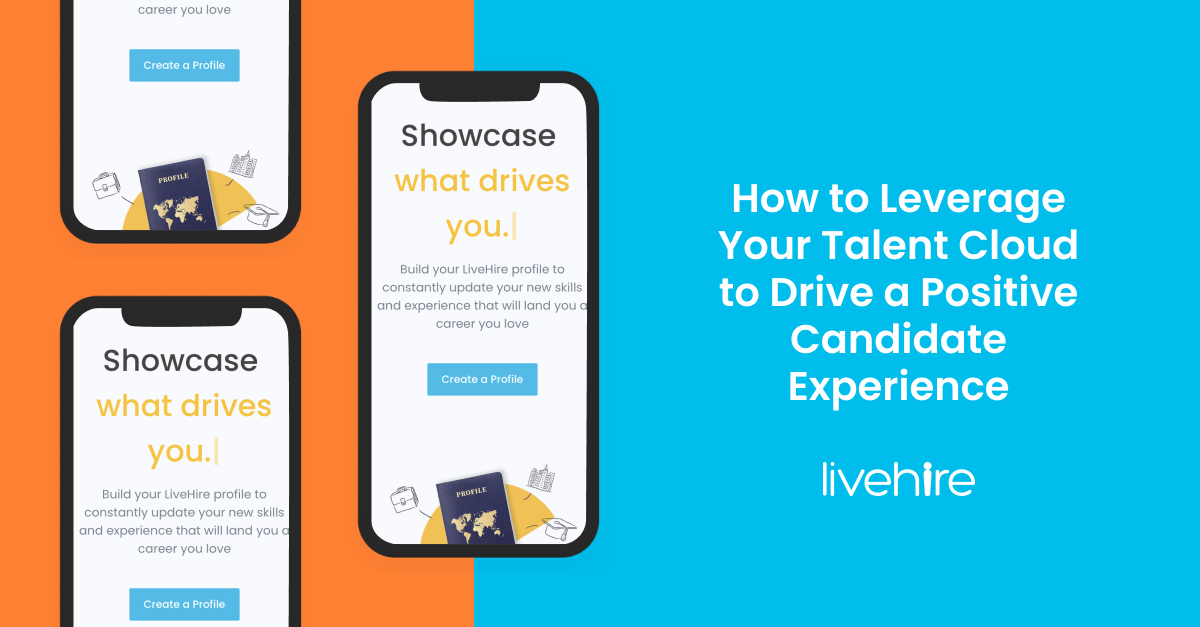
What is candidate sourcing?
Candidate sourcing involves searching for and qualifying eligible candidates for job opportunities which they have not applied for. These candidates may be active or passive. Industry reports indicate sourced candidates are more likely to be hired compared to applicants. The challenges of candidate sourcing for staffing agencies include: candidate shortages in their talent pool, absence of quality candidates, difficulty engaging and gaining traction with the right candidates, inconsistencies regarding candidate experience, drawn out time to hire and hard to fill roles.
What is the difference between an active and a passive candidate?
An active candidate is actively looking for new employment. They may be currently unemployed or not. Passive candidates are employed candidates who are not actively looking for a new role. Passive candidates make up approximately 70% of the global workforce. While, 30% of the total talent market is actively or semi-actively searching for a new job opportunity. However, the vast majority of the candidate universe is open to learning more at any given time.
Key benefits of candidate sourcing
Improves quality of hire
According to LinkedIn, passive candidates are 120% more likely to want to make an impact on a new employer’s business. Passive talent is also less likely to need skill development as they have been specifically approached for their skills and suitability for an existing or upcoming role. They are also more likely to be honest and upfront about their agendas as they already have secure employment.
Candidate centric experience
With the right AI optimized candidate sourcing tools in place, candidate sourcing can boost candidate experience through seamless, consistent communication, personalization and feedback.
Reduces time to hire and cost to hire
Candidate sourcing fast tracks time to hire as it doesn’t rely on waiting for suitable candidates to apply, rather it is a proactive approach to talent discovery. Furthermore this process ensures approached candidates are qualified and suitable for the role, where applicants may not be, reducing time and cost to hire. This is of particular benefit when considering contingent roles which by nature necessitate speedy turnaround times. Passive talent are also less likely than active or semi-active candidates to be interviewing elsewhere, thus reducing competition and time spent negotiating counter offers for the candidate.
Improves diversity
Candidate sourcing typically involves nurturing a pipeline of candidates prior to an immediate role becoming available which allows time for surfacing of candidates that might not fit the typical demographic profile for certain roles. When candidates are nurtured ahead of job openings there is time to bring underrepresented candidates along the applicant journey.
Cornerstones of candidate sourcing
1. Using a range of sources to find candidates: Candidates can be found in a wide range of places including social media platforms, online communities, existing databases, direct sourcing, and referrals. Staffing agencies currently rate referrals followed by LinkedIn, Indeed and agency websites as the most effective candidate sources.
Most effective Candidate Sources in 2021
Image source: https://staffinghub.com/2021-state-of-staffing-industry-benchmarking-report-pdf-download/
2. Adopting personalization: Identifying niche information of specific relevance to candidates results in higher engagement. Furthermore, personalization extends to understanding the profile of industry professionals being targeted.
3. Finding an effective and consistent cadence: Identifying a timeframe cadence for candidate outreach which can be streamlined via automation. Fast growth staffing agencies are significantly more likely to use software for texting and referral management.
4. Using the right candidate sourcing tools: Finding the right, innovative candidate sourcing technology enables organizations to drive efficiencies and achieve competitive recruitment targets. 40% of fast growth staffing agencies strongly agree that recruiting automation will transform the industry.
Candidate sourcing metrics
There are a range of metrics which can be used to determine candidate sourcing success and isolate specific stages of the candidate sourcing process. These include:
- Time to hire: For staffing agencies, this may be measured as time to submit. This metric can be improved dramatically through effective sourcing and talent pooling of well-fitted candidates. Learn more about how Raise Recruiting achieved 3 days time to submit by partnering with LiveHire.
- Invite acceptance rate: Measures the percentage of candidates that accept an invitation to join a shortlist for an available role.
- Sourced applicant to interview conversion rate: Measures sourcing strategy success by tracking the number of candidates that make it to interview stage; provides insights into the varying candidate quality based on specific sources.
- Candidates added to the talent pool: Evaluates the size and quality of a staffing agency’s talent pool. That is, the frequency that recruiters are adding quality candidates to a centralized talent pool.
- Candidates reviewed, tagged and pipelined: Beyond the quantity of candidates added to the talent pool, this metric tracks nurturing of potential applicants for future roles.
- Number of applicants: Measures how many new applications are produced from sourcing efforts.
- Quality of sourced hire: Quality of hire can be measured via a variety of methods such as retention rates and client satisfaction.
Features and benefits of leading candidate sourcing and management tools
- CRM that enables omni channel sourcing: Modern CRMs enable a seamless omni channel sourcing strategy that draws candidates into a single Talent Cloud. AI sourcing tools can be integrated as part of your sourcing workflow to find candidates online that fit specific requirements of a role. Omni channel sourcing ensures that the search for the right candidates is not limited. Traditional job boards are quickly becoming superseded by social media, with research finding 73% of job seekers aged 18-34 found their last job via social media. Furthermore, LinkedIn, Stackoverflow, user groups, Facebook and TikTok were identified as the current places the new generation of job seekers can be found. AI can also be leveraged to find patterns in resumes and other data to identify candidates that more accurately align with job requirements. At LiveHire we take this one step further, when you source leading talent, where do they go? LiveHire are market leaders in creating branded Talent Clouds. By ensuring top talent subscribe to your Talent Cloud you are better able to communicate and nurture on an ongoing basis.
- Decreased recruiting bias: By ignoring candidate demographics, modern candidate sourcing tools select candidates based on skills and experience that may not have been approached otherwise. Here at LiveHire, we take this one step further once talent is a member of your Talent Cloud. When you do win a job order, LiveHire’s AI smart matching will automatically find talent that best matches the role, searching 95 structured data points to ensure a top match, and with no bias.
- Candidate rediscovery: This allows passive candidates from your ATS that have previously applied for roles to be found and matched with current or upcoming opportunities. This is where LiveHire plays a leading role. Legacy ATS systems start with the job requisition and then source candidates, which takes additional time. By contrast, LiveHire’s intuitive CRM allows you to source, engage, and screen candidates before a hiring need arises, thereby developing a curated Talent Pool of candidates that are ready to hire.
- Optimized candidate experience: Via multi-modal automated communication including text messages and emails, candidate outreach can become seamless and consistent. Lack of communication from recruiters can be a key point of frustration for candidates. What we’ve learned at LiveHire is that you have to communicate with candidates on their preferred channel of communication. That’s why we built native 2-way text messaging into the platform, leading to an optimized candidate experience and median response time of 17 minutes.
- Branded Talent Clouds: Modern CRMs such as LiveHire enable organizations to attract talent by nurturing and growing a thriving Talent Cloud of qualified candidates.
The power here for a staffing supplier is twofold:
- A single destination for all talent interested in your staffing business and are loyal to you as recruiters and you can increase redeployment rates
- You can exclusively provide contractors for clients by implementing a Talent Cloud using their employer brand via a Managed Direct Sourcing offering.
Benefits LiveHire clients realize include candidates joining their Talent Cloud from multiple sources, having multiple brands exist under a single Talent Cloud and gaining total talent visibility across all candidates and contractors.






